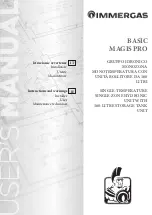
129
i.
Unplug the igniter, ground, and flame sensor wires
from the ignition electrode and the flame sensor (Figure 13.2).
j.
Use a 10 mm wrench to remove
fire door to the heat exchanger (Figure 13.2). Carefully remove the door/blower/
gas valve assembly from the heat exchanger, being careful not to damage the refractory insulation on the inside of
the door (see Refractory Warning on page 125) or the electrodes.
k.
Inspect the heat exchanger combustion chamber and vacuum
any debris found. If necessary, combustion
chamber may be brushed with a nonabrasive, nonmetallic brush. Do not use cleaning agents, solvents, acid or alkali
products of any type to clean the heat exchanger .
l.
Inspect the burner for heat damage
or other deterioration. Use compressed air to clean off dust or debris from
ports.
m.
Inspect igniter electrode and flame sensor
for deposits. Clean any found with steel wool. Do not use sand paper
or Emory cloth for this cleaning. Inspect the ceramic portion of both of these parts for cracks and replace if any are
found. Verify that the igniter gap is within the range shown in Figure 13.3.
n.
Inspect the blower gas valve assembly
, looking for dust, lint, or other debris that may have been drawn into this
assembly. Excessive deposits may be vacuumed out.
Inspect all rubber and plastic components on the blower/gas valve assembly, looking for deterioration. Replace
blower and/or gas valve if deterioration is found.
o.
Inspect and clean the condensate trap
. Place a bucket under the condensate cleanout cap on the bottom of the
boiler to catch water in the trap. Unscrew the cap. Flush any debris found in the trap with water – do not use other
cleaning agents. Reassemble the trap as shown in Figure 13.4.
XIII. Service and Maintenance
(continued)
WARNING
Asphyxiation Hazard. Do not operate the boiler without the float in place. Doing so could result in flue gas
leakage into the indoors resulting in personal injury or death from Carbon Monoxide (CO) poisoning.
NOTICE
Attempting to clean the heat exchanger or trap with anything other than water could result in condensate
backup, causing the boiler to shut-down.
CAUTION
Do not over tighten fire door mounting nuts. Doing so could break the fire door mounting studs. If any of
these studs are damaged, the heat exchanger must be replaced. Use of a short 10 mm box wrench will
reduce the risk of damaging these studs.
q.
Reinstall the fire door/blower/gas valve assembly
, following the above steps in reverse order.
r.
Inspect the vent system to verify that
:
• All gaskets and joints between the boiler heat exchanger and terminal are leak tight.
• All supports are intact and vent system is properly pitched
• All pipe is in good condition. Look for damage such as cracks, heat distortion, discoloration, and embrittlement.
If any such damage is found, the pipe must be replaced and the cause of the damage identified and corrected.
• Vent/Intake terminals are in good condition, free from blockages, and still correctly located relative to doors,
windows,
decks,
etc.
• There is no gasoline, flammable liquids/vapors, or halogen based products stored in the vicinity of the
vent or inlet terminals. Also verify that there are no chemical products containing chlorine, chloride based salts,
chlorofluorocarbons, paint removers, cleaning solvents, or detergents stored near the air intake terminal.
Summary of Contents for Raptor RPTR085
Page 1: ...1...
Page 13: ...13 Figure 5 1 Wall Layout Mounting Hole Location V Mounting The Boiler continued...
Page 87: ...87 Figure 10 5 Internal Wiring Ladder Diagram X Wiring continued...
Page 88: ...88 X Wiring continued...
Page 97: ...97 Operating Instructions XI Start Up and Checkout continued...
Page 142: ...142 XV Repair Parts continued 3A 3B 3C 3D 3F 3E 3G 3H 3O 3P 3Q 3R 3J 3K 3I 3M 3N 3L All Models...
Page 148: ...148 XV Repair Parts continued 6D 6B 6A 6E 6I 6G 6L 6N 6H 6C 6K 6M 6C 6C 6J 6J 6F All Models...
Page 172: ...172...
















































